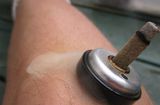Spa Therapies Of China
Moxibustion (Jiu Fa):

Moxibustion (jiu fa), the burning of the herb moxa or Artemisia Vulgaris around acupoints, can be traced back centuries to Chinese pheasants who burnt herbs around parts of the body to relieve pain. In an earlier hormed, heated rocks or hot sand wrapped in animal skin or tree bark were used in hot compresses to warm afflicted body parts.
Today moxibustion is often applied using lit cylindrical moxa sticks that are filled with pressed Artemisia leaves mixed with other herbs and rolled in thin paper. These are moved at a short distance from the skin along the meridian lines, or rotated around affected areas to cause heat to enter the body. This encourages the circulation of blood and flow of qi. Moxibustion is also applied using cones of moxa directly on the skin, or more commonly, indirectly with an insulating layer of other herbs. These insulations give an added effect to the treatment; ginger, for instance, releases warmth.
Acupuncture and moxibustion are often combined. In fact, the Chinese term ‘zhen jiu‘ (acupuncture and moxibustion) refers to both the insertion of needles and the application of moxibustion on the skin to restore the body’s energy to harmony. When used in conjunction with acupuncture, the moxa cones are placed at the ends of inserted acupuncture needles and lit, allowing the heat and curative effects of the herb to be conducted into the body without leaving a scar. Moxa is thought to be yang in nature, and particularly effective when you are suffering from problems such as joint pain and stiffness caused by dampness and cold climates. It is not suitable for those suffering from heat.